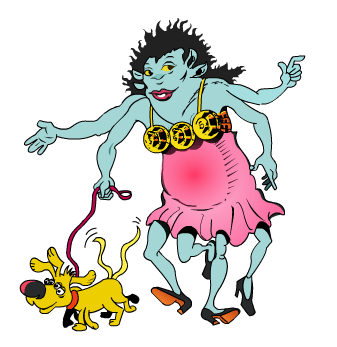multi-, mult-
(Latin: much, many; combining form of Latin multus "much, many"; which is related to the Greek mala, "very, very much, exceedingly")
2. An expression of two or more terms.
2. Having carried more than one pregnancy to a viable stage.
2. An insect having many feet; such as, a polyped or a myriapod.


Life is full of multiple experiences, situations, and choices; both good and bad.
2. Existing concurrently in several parts of the body: Multiple myeloma is a malignant neoplasm of plasma cells in that they proliferate and invade the bone marrow which causes destruction of the bone and usually results in a pathological fracture and considerable pain of the bones.
Go to this Word A Day Revisited Index
so you can see more of Mickey Bach's cartoons.
Some RFID readers use Time Division Multiple Access, or TDMA, meaning they read tags at different times to avoid interfering with one another.
The multiple hamartomas may appear in blood vessels, and in the lung and kidney.
Multiple hamartomas are not malignant, but they cause symptoms of an illness because of the spaces they occupy.
2. A cancer that begins in plasma cells.
Plasma cells are white blood cells which make antibodies. Antibodies are part of the immune system. They work with other parts of the immune system to help protect the body from germs and other harmful substances. Each type of plasma cell makes a different antibody.
Myeloma, like other cancers, begins in cells. Normally, cells grow and divide to form new cells as the body needs them.
When cells grow old, they die, and new cells take their place. In cancer, this orderly process goes wrong. New cells form when the body does not need them, and old cells do not die when they should. These extra cells can form a mass of tissue called a growth or tumor.
Myeloma begins when a plasma cell becomes abnormal and that abnormal cell divides to make copies of itself. The new cells divide again and again, making more and more abnormal cells. The abnormal plasma cells are myeloma cells.
In time, myeloma cells collect in the bone marrow where they may crowd out normal blood cells. Myeloma cells also collect in the solid part of the bone.
The disease is called multiple myeloma because it affects many bones. If myeloma cells collect in only one bone, the single mass is called a plasmacytoma or cancer of the plasma cells (white blood cells that produce antibodies).
As myeloma cells increase in number, they damage and weaken the bones, causing pain and often fractures. When bones are damaged, too much calcium is released into the blood, leading to loss of appetite, nausea, thirst, fatigue, muscle weakness, restlessness, and confusion.
Chemotherapy and bone marrow transplant are currently the primary treatments.


